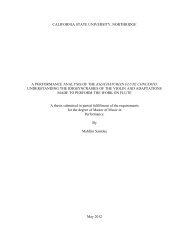Page 1 The California ""- Geographer Annual Publication of the ...
Page 1 The California ""- Geographer Annual Publication of the ...
Page 1 The California ""- Geographer Annual Publication of the ...
Create successful ePaper yourself
Turn your PDF publications into a flip-book with our unique Google optimized e-Paper software.
Laguna Ojo de Liebi·e. Afternoon ebbs carry away water that is perceptibly<br />
warmer than floods <strong>of</strong> an earlier hour. This follows, no doubt,<br />
from insolation <strong>of</strong> <strong>the</strong> sheets <strong>of</strong> water lying across <strong>the</strong> broad shelves <strong>of</strong><br />
<strong>the</strong> flats. Horizontal underwater visibility varies during tidal stand from<br />
8 to ll feet during hours <strong>of</strong> bright sunshine. 4 When tides are flowing<br />
however, suspended debris turns <strong>the</strong> water murky. Tidal ranges are 3 to<br />
5 feet. 5<br />
Waters <strong>of</strong> Laguna Guerrero Negro are known to be isohaline.6<br />
(<strong>The</strong>re is no route by which salt brine from <strong>the</strong> industrial beds can drain<br />
into <strong>the</strong> lagoons.) Mid-summer salinities are 35.5 to 37.5 parts per thousand<br />
(0/00), while those <strong>of</strong> <strong>the</strong> winter are 34.7 to 35.6 (0/00). Presumably,<br />
this indicates <strong>the</strong> influences <strong>of</strong> increased evaporation and insolation<br />
during <strong>the</strong> summer months. Flood tide salinities, naturally, are more dilute<br />
than those <strong>of</strong> ebbs.<br />
Bottom sediments <strong>of</strong> <strong>the</strong> lagoon basin are predominantly minute<br />
gray sand particles intermixed with organic silt. <strong>The</strong>re are occasional outcrops<br />
<strong>of</strong> fine-grained fossiliferous sandstone strata. A coquina specimen<br />
taken · from <strong>the</strong> sou<strong>the</strong>rn part <strong>of</strong> <strong>the</strong> lagoon proved to be cemented detrital<br />
limestone. <strong>The</strong> cement was calcium carbonate, and detrital components<br />
were shell fragments plus pulverized foramens. 7 Occasional cobbles <strong>of</strong><br />
limestone appear in dredge tailings.<br />
Extensive salt beds surround <strong>the</strong> head <strong>of</strong> <strong>the</strong> lagoon, and in <strong>the</strong>se<br />
<strong>the</strong> overburden is ei<strong>the</strong>r pure salt or a mixture <strong>of</strong> salt and wind-blown<br />
sand. Levees separate <strong>the</strong> industrial sites from <strong>the</strong> natural tidal pans.<br />
CLIMATE;<br />
-Although <strong>the</strong> lagoon lies in <strong>the</strong> hot and dry BW climatic zone, 8<br />
<strong>the</strong> wintertime climate is benign because <strong>of</strong> <strong>the</strong> <strong>of</strong>fshore <strong>California</strong> current<br />
and upwelling in Bahia Sebastian Vizcaino.9 \iVea<strong>the</strong>r observations recorded<br />
in <strong>the</strong> port captain's log indicate that <strong>the</strong> mean monthly maximum<br />
temperature runs from 68 to 95 degrees F. and <strong>the</strong> minima from 30 to 48.<br />
Wintertime temperatures are in <strong>the</strong> mid-eighties, but are tempered by a<br />
daily afternoon breeze (12- 16 knots). January is <strong>the</strong> usual period for<br />
freezing. In <strong>the</strong> late summer, temperatures regularly pass into <strong>the</strong> nineties<br />
but may go as low as 45 degrees at night.<br />
After <strong>the</strong> spring equinox, <strong>the</strong> area is periodically dominated by 20- to<br />
30-knot northwesterly winds in <strong>the</strong> afternoon.10 This may last for 8 or<br />
9 days and be followed by 3 to 5 days <strong>of</strong> gentle breezes. Occasionally<br />
warm winds sweep out from <strong>the</strong> desert. In <strong>the</strong> fall, pressure gradients<br />
over <strong>the</strong> mainland fur<strong>the</strong>r curtail any wind, and, accordingly, temperatures<br />
remain high.<br />
4 Evans, William E., and Wheeler North, personal observations, 1963.<br />
5 U.S. Coast and Geodetic Survey, Tide Tables, High and Low Wate1· Predictions,<br />
1964, West Coast North and South America Including <strong>the</strong> Hawaiian Islands,<br />
1962, pp. 70-73.<br />
6 Phleger, and Ewing, loc. cit.<br />
7 Inderbitzen, Anton, personal communication, 1963.<br />
8 Espenshade, Edward B., ed., Goode's World Atlas, 11th ed., Chicago, Rand<br />
McNally & Company, 1960, pp. 8-9.<br />
9 U.S. Hydrographic Office, loc. cit.<br />
10 Ibid. and Phleger and Ewing, lac. cit.<br />
32













